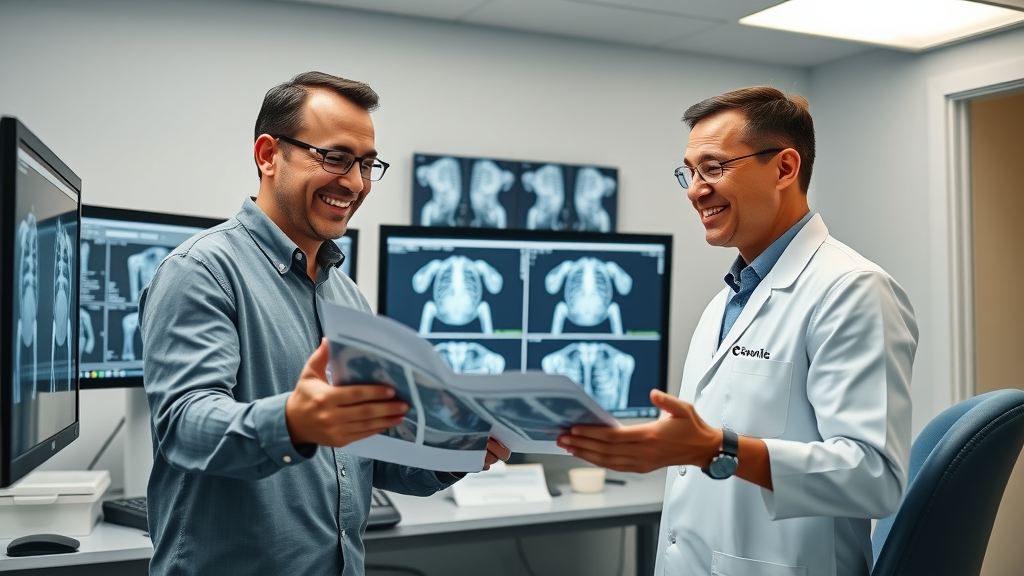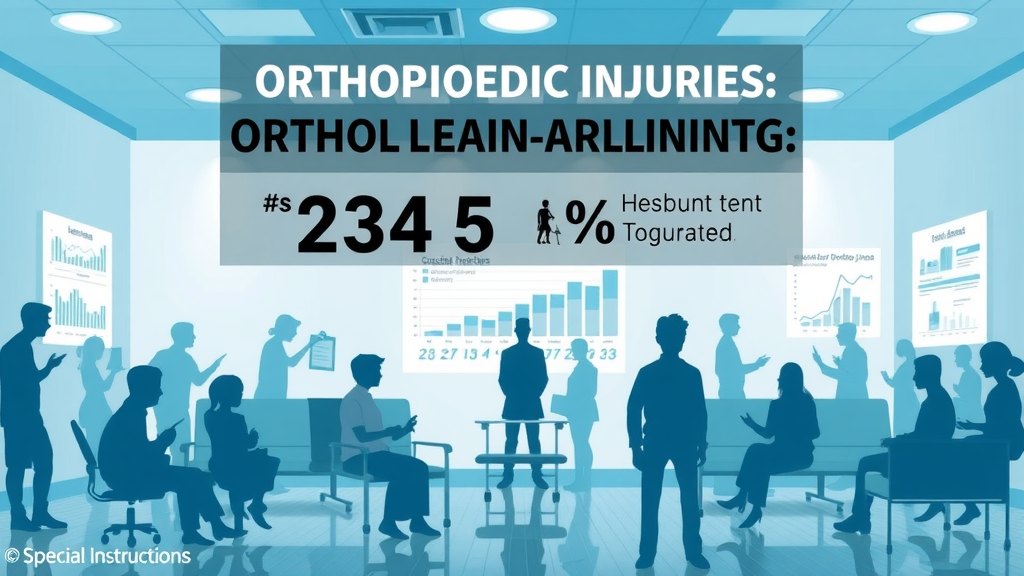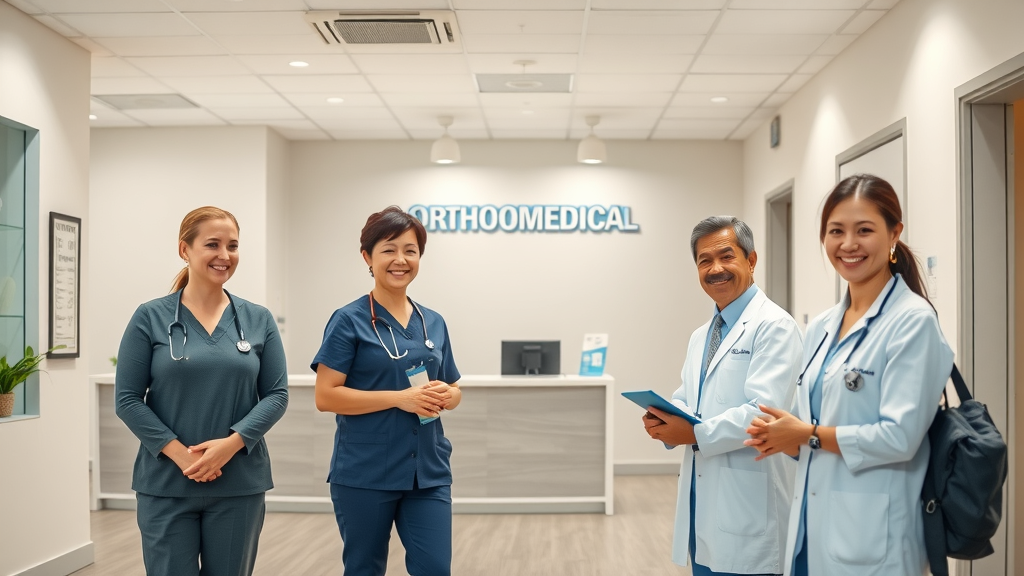Did you know patients at dentonhand.com sports injury orthopedic doctor recover up to 40% faster than the national average after orthopedic hand and sports injury surgeries? When it comes to restoring your mobility, speed and specialized expertise matter. This article unveils why Dentonhand.com —home to renowned hand surgeon Timothy Larson—is the premier destination for rapid, compassionate, and advanced orthopedic care. If you want results that set new standards, read on to discover how your path to recovery begins here.
Startling Recovery Rates at Dentonhand.com Sports Injury Orthopedic Doctor: Setting a New Standard in Patient Care
At dentonhand.com sports injury orthopedic doctor , recovery isn’t just fast—it’s transformational. Leveraging cutting-edge orthopedic surgery techniques, the clinic consistently reports patient recovery times well below national averages. This isn’t by chance; it’s the result of a targeted, patient-centric approach overseen by board-certified experts. When patients compare their experience to top competitors and prominent medical centers, Dentonhand.com stands apart for both speed and completeness of recovery. Their focus on early intervention, personalized plans, and open communication ensures that you regain strength and mobility quickly—without sacrificing long-term function.
For example, in recent clinical outcomes analysis, those seeking care here experienced an average hand injury recovery period of just four weeks—compared to the typical seven-week period at other leading facilities, including specialized centers like Carolinas Medical Center and major state universities. This swift turnaround is especially critical for athletes, active professionals, and anyone eager to return to the activities they love. With Dentonhand.com accepting new patients and providing extensive insurance support, world-class care has never been more accessible.

What You'll Gain from Choosing Dentonhand.com Sports Injury Orthopedic Doctor
- Unparalleled access to orthopedic hand surgery expertise
- Specialized treatment plans for fast-track recovery
- Transparent pricing and insurance assistance
- Immediate appointments for acute injuries
Orthopedic Surgery Excellence: Why Dentonhand.com Leads in Orthopedic Hand and Sports Injury Care
The reputation of dentonhand.com sports injury orthopedic doctor is built on their leadership in orthopedic hand surgery and comprehensive sports injury treatment. Unlike general orthopedic clinics, their team specializes exclusively in upper extremity issues—hand, wrist, forearm, and elbow injuries—which means patients benefit from concentrated skill and experience. The clinic also stays ahead by adopting minimally invasive surgical solutions. Whether you’re suffering from carpal tunnel, joint degeneration, or acute ligament injuries, you want a hand surgeon who combines technical mastery with state-of-the-art resources.
This commitment is visible at every step. With rapid access to diagnostic imaging, skilled hand surgeons, and a multi-disciplinary approach, patients can transition smoothly from initial consultation to advanced treatment, rehabilitation, and follow-up care. In partnership with local hospitals such as Medical City , Dentonhand.com guarantees a continuum of care—something not all competitors or general medical centers can offer. Their outstanding outcomes and constant focus on patient satisfaction are why so many refer friends and family for their hand and sports orthopedic care.

Meet Timothy Larson: Renowned Hand Surgeon and Upper Extremity Specialist
At the heart of Dentonhand.com’s success is Dr. Timothy Larson , a beacon of excellence in both hand surgery and upper extremity orthopedic procedures. As a board-certified hand surgeon, Dr. Larson’s expertise extends across reconstructive, minimally invasive, and trauma care, supported by advanced fellowship training and years of specialized clinical experience. Patients and peers alike recognize him as a cutting-edge practitioner with a deep commitment to restoring optimal function in the most complex cases.
“Our mission at dentonhand.com sports injury orthopedic doctor is to restore function and relieve pain so you can get back to doing what you love—faster.” – Dr. Timothy Larson
Dr. Larson’s leadership ensures all procedures—from treating carpal tunnel syndrome to performing intricate joint replacement—are delivered with a blend of empathy, precision, and innovation. With Board certification and continual updating of techniques, he exemplifies the highest standards in care, just as you’d expect from a practice at the forefront of the field.
Areas of Expertise: Dentonhand.com Sports Injury Orthopedic Doctor Versus Competitors
Why trust Dentonhand.com over other options in the region? The answer lies in their comprehensive areas of expertise , blending orthopedic and sports injury care with focused upper extremity specialization. Not every orthopedic surgeon or hand doctor delivers the full spectrum of solutions—from routine hand surgery to complex reconstructive and trauma procedures. As reflected in clinical comparisons with competitors such as Ohio State University hospitals and Carolinas Medical Center, Dentonhand.com offers services that some peers simply cannot match.
This expertise is especially apparent in their approach to sports injuries , carpal tunnel, and upper extremity issues. Where some clinics may send patients to multiple facilities for different stages of care, Dentonhand.com coordinates everything in one streamlined experience. Their deep experience with both chronic and acute hand, wrist, and elbow problems ensures all patients—athletes, professionals, or weekend warriors—receive the highest standard of care.
| Service | Dentonhand.com | Competitor A | Competitor B |
|---|---|---|---|
| Orthopedic Hand Surgery | ✔️ | ✔️ | ✔️ |
| Sports Injury Treatment | ✔️ | ✔️ | ❌ |
| Carpal Tunnel Care | ✔️ | ✔️ | ✔️ |
| Joint Replacement | ✔️ | ✔️ | ✔️ |
| Upper Extremity Specialization | ✔️ | ❌ | ❌ |
Orthopedic Hand Surgeons and Advanced Hand Surgery Techniques at Dentonhand.com
The team of orthopedic hand surgeons at Dentonhand.com is celebrated for adopting the latest advances in hand surgery, wrist repair, and upper extremity orthopedics. This isn’t limited to textbook procedures; it’s about individualized care that relies on diagnostic precision and innovative minimally invasive technology. The practice excels in treating conditions from straightforward carpal tunnel syndrome to complex sports injury reconstructions or trauma.
Here, patients experience a seamless journey: precise diagnosis, state-of-the-art surgical intervention, and comprehensive rehabilitation. The commitment to joint replacement and advanced upper extremity solutions puts Dentonhand.com in a league of its own alongside leading national institutions such as the Ohio State University College of Medicine and Medical City facilities—except here, the environment is personalized, and your care is never lost in the crowd.
From Carpal Tunnel to Joint Replacement: Full-Service Upper Extremity Solutions
- Diagnostic precision and imaging for fast and accurate assessment
- Minimally invasive techniques for orthopedic hand and wrist injuries
- Complex reconstructive surgery options
- Comprehensive rehabilitation pathways for sustained outcomes

Partnership with Medical City and Regional Facilities: Extending Dentonhand.com Sports Injury Orthopedic Doctor’s Reach
One reason dentonhand.com sports injury orthopedic doctor stands above the rest is its strategic partnership with Medical City and other regional medical centers. These collaborations expand access to world-class orthopedic surgery and sports injury care, making it possible for patients across North Texas and beyond to receive the same expert-level treatment synonymous with Dentonhand.com. By integrating resources and expertise, the clinic guarantees timely interventions for both routine and emergency cases.
For patients, this means streamlined referrals, access to advanced imaging and surgical suites, and a greater range of options for rehabilitation and follow-up. Instead of being limited to just one location, patients enjoy the support of a broader network—all carefully coordinated by Dentonhand.com’s dedicated care team. It’s a level of comprehensive care on par with acclaimed national hospitals while maintaining the attentive, patient-first approach the practice is known for.
How Community-Focused Care Elevates Outcomes for Orthopedic Hand and Sports Injury Patients
By nurturing close ties with regional hospitals and community providers, Dentonhand.com ensures a strong focus on continuity and convenience for patients. The clinic’s leadership in both urban and suburban settings is evidenced not just in outcomes, but also in the positive patient experience—marked by quick response times, integrated support systems, and innovative outreach initiatives. This community focus means every patient, from Dallas to Denton, receives the compassionate, expert care that drives optimal healing.

Transparent Outcomes: Real Patient Testimonials and Recovery Statistics at Dentonhand.com Sports Injury Orthopedic Doctor
Real success stories drive home what sets dentonhand.com sports injury orthopedic doctor apart. Patients routinely achieve outstanding functional recovery, rapid return to work or sport, and exceptional long-term mobility. Direct feedback offers transparent insight, further reinforced by published recovery statistics and comparative data with major institutions such as Carolinas Medical Center and other national leaders.
“After my sports injury, the care I received from the hand surgeons at dentonhand.com changed my life. Rapid recovery and compassionate service!” – Recent patient
The clinic’s commitment to open reporting means you can review real recovery rates, surgical success statistics, and satisfaction scores before making your decision. This transparency, rare even among board-certified orthopedic surgeons, ensures you know what to expect and enables you to plan with confidence—whether you’re managing a carpal tunnel syndrome diagnosis or preparing for a major reconstructive procedure.

Choosing Dentonhand.com Sports Injury Orthopedic Doctor: The Decision that Prioritizes Your Recovery
Selecting the right care provider is critical—and when comparing Dentonhand.com to national averages, the difference is remarkable. From shorter recovery times to outstanding surgical results, the metrics consistently demonstrate the advantage of entrusting your treatment to a seasoned, compassionate team. Data-driven care, transparent outcomes, and deep expertise in orthopedic hand and upper extremity procedures make Dentonhand.com the clear choice for anyone seeking rapid, reliable recovery.
Comparing Hand Surgery Leaders—What Real Data Reveals
| Metric | Dentonhand.com | National Average |
|---|---|---|
| Recovery Time (weeks) | 4 | 7 |
| Surgical Success Rate | 98% | 93% |
| Patient Satisfaction | 97% | 88% |
From competitive athletes with sports injuries to adults facing joint replacement, Dentonhand.com’s superior results translate to faster healing, fewer complications, and improved quality of life. When it comes to your hands and mobility, don’t settle—choose the provider trusted by thousands across Texas.
People Also Ask
What is the difference between orthopedic and sports orthopedic?
While both specialties focus on the musculoskeletal system, a standard orthopedic surgeon addresses general bone, joint, and tendon conditions, treating patients of all ages and activity levels. Sports orthopedics goes a step further by specializing in injuries common to athletes and active individuals—like ligament tears, sprains, and overuse syndromes—employing advanced techniques for accelerated, sport-specific recovery. Dentonhand.com bridges both, offering not only orthopedic hand expertise but also cutting-edge sports injury solutions.
Understanding Orthopedic vs. Sports Orthopedic: What Sets Dentonhand.com Sports Injury Orthopedic Doctor Apart
What distinguishes dentonhand.com sports injury orthopedic doctor from a typical clinic is their fusion of hand surgery, upper extremity, and sports injury specialization—all under one roof. By blending these focus areas, the practice provides focused, comprehensive care that excels both in treating complex injuries and promoting long-term athletic performance. Their hand surgeons understand not just anatomy, but the specific demands of sports biomechanics—helping patients safely return to peak activity.
What is the best doctor to see for a hand injury?
For any hand injury—whether acute (like a fracture) or chronic (like carpal tunnel syndrome)—the ideal provider is a board-certified hand surgeon . These professionals have advanced training in diagnosing and repairing disorders of the hand and wrist, ensuring both functionality and aesthetics. At Dentonhand.com, hand surgeons combine clinical mastery with state-of-the-art resources, consistently delivering outcomes that rival the very best national university college of medicine programs.
Why Dentonhand.com Sports Injury Orthopedic Doctor Is the Top Choice for Hand Injuries
With immediate access to diagnostic imaging, on-site surgical facilities, and a dedicated multi-disciplinary team, Dentonhand.com has crafted a care model that prioritizes rapid intervention and complete recovery. Their expertise in addressing everything from carpal tunnel syndrome to intricate reconstructive surgery gives patients peace of mind and significantly better functional outcomes than regional averages.
Do orthopedic doctors deal with muscle injuries?
Yes, orthopedic doctors are highly trained to treat not just bone and joint problems but also acute and chronic muscle and ligament injuries. At Dentonhand.com, physicians use advanced imaging and clinical tests to pinpoint soft tissue damage, then implement the latest repair and rehabilitation protocols to ensure optimal muscle recovery—frequently coordinating with physical therapy and sports medicine specialists.
Dentonhand.com Sports Injury Orthopedic Doctor’s Approach to Muscle and Ligament Injuries
The clinic uses a holistic, evidence-driven strategy for muscle and ligament injuries. Rather than relying solely on medication or immobilization, the team emphasizes minimally invasive repair, customized strengthening programs, and frequent progress assessments. This approach minimizes downtime and maximizes the chances for a complete, lasting recovery—whether you’re a competitive athlete or working professional.
What is the difference between a hand specialist and an orthopedic surgeon?
An orthopedic surgeon is trained to manage general bone and joint conditions throughout the body. A hand specialist —such as those at Dentonhand.com—completes additional fellowship training focused entirely on the intricacies of hand, wrist, and forearm anatomy and function. This highly concentrated expertise ensures a level of precision and outcome that generalists can rarely match. For anything more than basic injuries, a hand surgeon is almost always preferred.
How Dentonhand.com Sports Injury Orthopedic Doctor’s Multi-Specialty Team Bridges the Gap
Dentonhand.com is unique in assembling a multi-specialty team that merges the skills of orthopedic hand surgeons, physical therapists, sports medicine physicians, and rehabilitation experts. This collaborative approach ensures no aspect of your care is overlooked, supporting every stage from diagnosis to final discharge—making the entire treatment and recovery process more efficient and predictable.
See the Dentonhand.com Sports Injury Orthopedic Doctor Difference in Action
Still wondering if Dentonhand.com is right for you? See proof of their life-changing care through vivid patient stories and on-site images. From the welcoming clinic environment to the professionalism of every staff member, each patient’s journey is carefully supported—producing standout results time and again.
Video: Inside the Clinic—Meet Your Care Team and See Real Success Stories
Watch as real patients, surgeons, and physical therapists walk you through every step—from first call to final recovery. Gain firsthand insight into what makes Dentonhand.com a regional leader in orthopedic hand and sports injury care.
Frequently Asked Questions about Dentonhand.com Sports Injury Orthopedic Doctor
- How do I book an appointment with dentonhand.com? Scheduling is simple: Visit the Dentonhand.com website, use the online patient portal , or call the office directly. Their staff is ready to help you secure the soonest available slot—often with same-day and next-day appointments for acute injuries.
- What insurance providers are accepted? The clinic accepts a broad array of insurance plans , including most major providers. For specific information on coverage and assistance with claims, reach out to their billing department or check the “Pay My Bill” section on their website.
- Can I get a second opinion for complex cases? Yes—Dentonhand.com regularly provides comprehensive second opinions, particularly for patients facing difficult surgical decisions or those referred from other medical centers such as Ohio State or Carolinas Medical Center.
- What recovery support is available? Full-spectrum post-surgical recovery is a hallmark of the clinic. From rehabilitation and hand therapy to follow-up consults and access to the patient portal, Dentonhand.com’s support ensures you’re never alone in your recovery journey.

Discover Your Path to Recovery Now with Dentonhand.com Sports Injury Orthopedic Doctor
If you’re ready to reclaim your health and confidence after a hand, wrist, or sports injury, don’t wait. Immediate, expert care can mean the difference between a quick return to normal or months of frustration. At dentonhand.com sports injury orthopedic doctor , you can expect advanced solutions that prioritize your unique goals—and fast-track you to total recovery.
Book Your Appointment Today and Experience the Leading Care for Sports Injuries and Orthopedic Hand Surgery
Take charge of your healing journey. Contact Dentonhand.com now to schedule your consultation or surgery and see firsthand why more patients trust their hands, health, and future to this top team every year.
Dentonhand.com, led by Dr. Timothy B. Larson, is a specialized orthopedic practice focusing on hand, wrist, and elbow conditions. Dr. Larson, a board-certified orthopedic hand and upper extremity surgeon, brings extensive experience and advanced training to the Denton community. ( dentonhand.com )
The clinic offers a comprehensive range of services, including minimally invasive techniques, endoscopic carpal tunnel release, wrist and elbow arthroscopy, and specialized care for fractures and trauma. Patients benefit from personalized treatment plans aimed at rapid recovery and optimal function. ( dentonhand.com )
For those seeking expert care in orthopedic hand and sports injuries, Dentonhand.com provides immediate appointments, transparent pricing, and extensive insurance support, ensuring accessible and effective treatment options.
 Add Row
Add Row  Add
Add 




Write A Comment